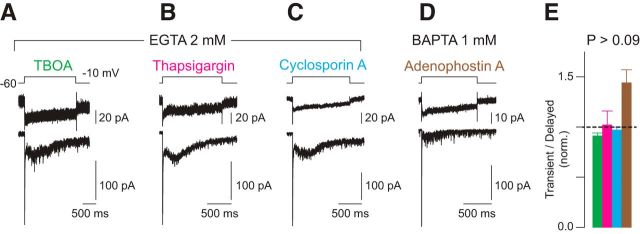Figure 3.
The delayed EPSC reflects Ca channel-dependent vesicular exocytosis. A, Delayed release persists in the presence of the glutamate transporter blocker TBOA (100 μm). B–D, Ca2+ released from intracellular stores does not affect delayed release. Delayed release persists in the presence of thapsigargin, an antagonist of the SERCA pump (B), of cyclosporin A, a mitochondrial toxin (C), and of adenophostin A, an IP3 receptor agonist (D). E, Summary data for the four conditions. Error bars are means ± SEM. The ratios of the integrals of the transient components of the EPSCs and the remainders of the EPSCs in experimental conditions are normalized to those measured under control conditions. The adenophostin A was applied in an internal pipette solution containing 1 mm BAPTA; the other agents were bath applied during recordings that used 2 mm EGTA as a presynaptic buffer. For TBOA, n = 12 paired recordings and p = 0.4 by Wilcoxon–Mann–Whitney test. For thapsigargin, n = 5 paired recordings and p = 0.9 by Wilcoxon–Mann–Whitney test. For cyclosporin A, n = 4 paired recordings and p = 0.8 by Wilcoxon–Mann–Whitney test. For adenophostin A, n = 6 paired recordings and p = 0.09 by Wilcoxon–Mann–Whitney test.

